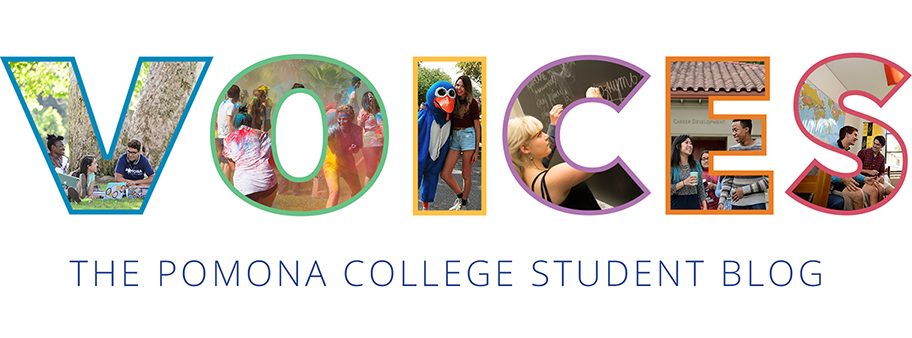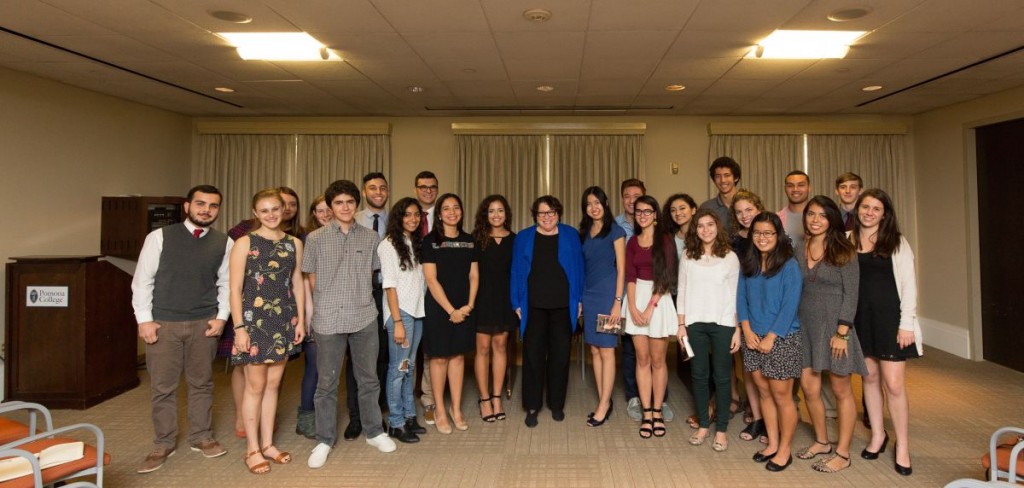SETTING: Our Beloved World
CHARACTERS: All the people in it
SCENE: Pomona College, Claremont, CA
Thursday, 3:30 pm. I walked out of my International Relations class, trying to put aside the heaviness sparked by the discussion on the Rwanda genocide and other ethnic conflicts. The first floor of Carnegie Hall — that classy building resembling the White House to some degree, home to the politics and economics departments at Pomona College — was quiet. It was a perfect autumn afternoon in Southern California: the sky was azure, the breeze mild, the temperature moderate. And I was to meet a United States Supreme Court Justice in roughly fifteen minutes.
The venue was right across from Carnegie. My parents, who were visiting from China, waved to me as I crossed the street. In front of me stood Alexander Hall, where I work every Friday (at the Office of Communications). Inside it, I would find the Justice’s marshals evenly distributed across the space, each looking very serious. Indeed, the Justice herself, during the public talk that evening, described them as “the very professional-looking men and women in suits who are here to protect me from me instead of from you”.
“Are you the Justice’s student escort? This way.”
Yes. I arrived at the area next to the President’s Office. The door was not yet wide open enough for me to catch a glimpse of the Justice herself. And so prolonged my eagerness and anticipation.
3:51 pm. She walked out of the room with a personable smile, after much suspense. Sonia Sotomayor, Supreme Court Justice. Wow!
We shook hands and exchanged greetings. The camera captured this magical moment. Justice Sotomayor asked me about my year and my major, shared her perspective on double majoring, and talked about her “eventful flight” the night before, as well as her morning visit to the Sotomayor School in Los Angles, just prior to her visit to our campus. We walked side by side.
I did not feel nervous at all as I gave that brief two-minute tour of Alexander Hall and Smith Campus Center for her; rather, I felt extremely comfortable. I adored how the Justice was so curious about everything around us, constantly asking questions like “What’s that building?”, “Where are you taking me now?” and “And what do you use that room for?”. I revered her sense of curiosity, which one could easily see as a recurring element throughout her autobiography My Beloved World, a candid reflection on her life prior to the Supreme Court of the United States. Although too much curiosity may kill the cat, sufficient curiosity, as Justice Sotomayor has demonstrated from her early childhood, can be quite a positive personality attribute.
Truly, even though my time to interact with her this closely was very limited, I could see why she is known as “the People’s Judge” of the SCOTUS (just to name two examples, it might be difficult to imagine a SCOTUS Justice shopping at Costco or making an appearance on ABC’s daytime talkshow The View in front of 2-3 million viewers, but this is precisely what Justice Sotomayor has done).
Whilst I thoroughly enjoyed everything the Justice had shared with the Pomona College community later in the day about her identity as a woman of colour sitting on the Bench and her experience as a former first generation and low income college student, one of the themes that stood out to me the most was her candid discussion of the “Imposter Syndrome”.
Justice Sotomayor, who might come across to anyone as extremely confident, admitted that she did not always feel a sense of belonging when she started school at Princeton, at Yale Law School or later, during her career. For her, Princeton’s gothic architecture seemed like a fantasy, so different from the environment from which she came. Fortunately, like many of us, the Justice was able to overcome these initial difficulties with others’ support. Somewhat surprisingly, she also mentioned the worsening of the imposter syndrome when she joined the Supreme Court, citing her colleagues’s jaw-dropping level of intelligence and breadth of knowledge, ranging from the Constitution to opera, as the reasons for this.
Although our personal backgrounds are most likely very different from that of the Justice, we can certainly identify with her, for there are many challenges that we all face in life: academic, professional, and personal. We can feel intimidated by long to-do lists, tough assignments, or strange surroundings that we do not perceive as genuinely welcoming. Yet, as the Justice puts it (having walked off-stage to join the audience to engage with us in a more intimate fashion), “You’re there for a reason — you’re there to do something that’s unique to you”. It doesn’t matter if we are cultured differently or have grown up in any one distinct way. I learned from the Justice that we need to compare ourselves to ourselves, not to others around us.
In our beloved world, there is a giant marble temple which, curiously, is not as dated as it looks. 36 steps lead up to this prominent symbol of justice. Yet, for many individuals aspiring to sit on the Bench, the steps seem innumerable. For more than a hundred years, only white, generally wealthy men were able to reach that Bench; only in the past decades have women and people of colour joined these men in becoming Supreme Court Justices.
The Court today is, in many ways, still homogenous. The Justices all have an Ivy League education and have all served exclusively as judges in their career — unlike previous Supreme Court Justices, who served as politicians for many years. Whilst one may argue that this homogeneity is good, it simultaneously limits the Supreme Court’s connections with politics outside of this marble temple. As the first woman of colour to obtain this much coveted position, Justice Sotomayor is an inspiring trailblazer who bridges the gap between the Court and the public by staying connected with her communities: her beloved world.
Our beloved world.

